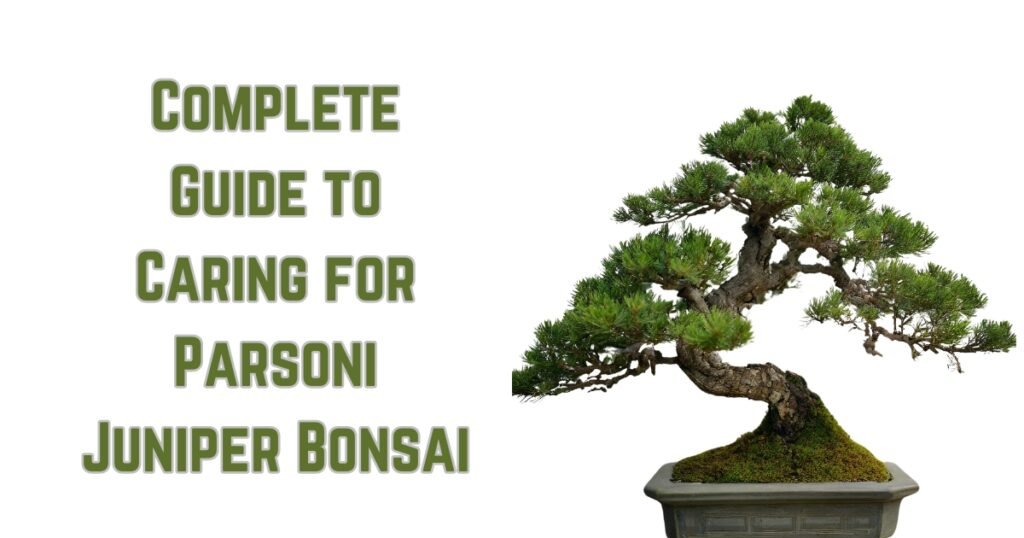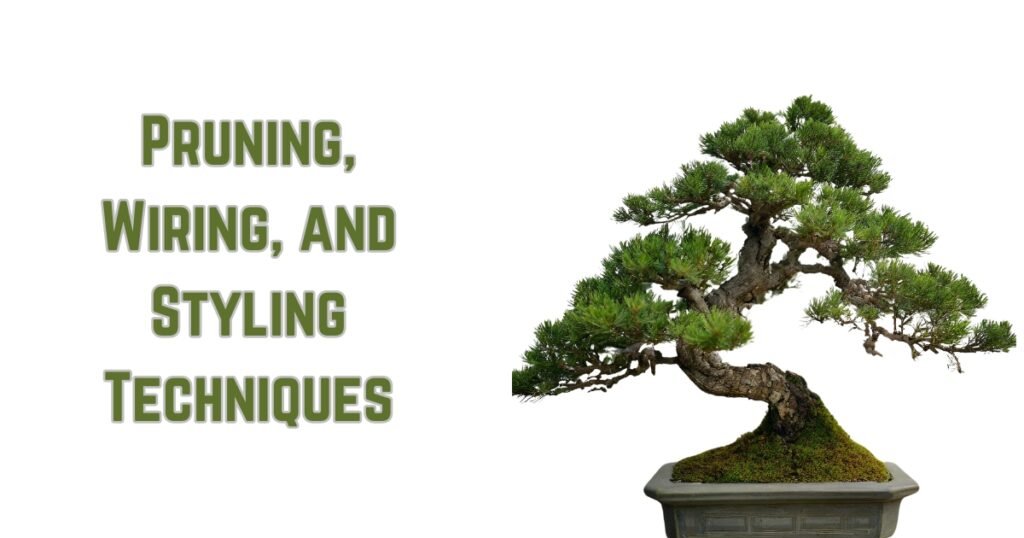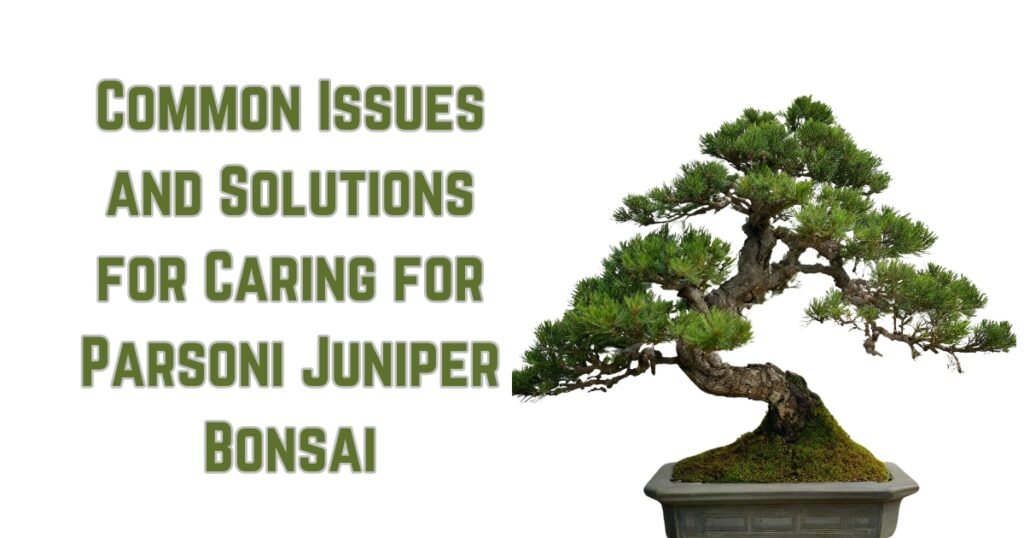Introduction
The Parsoni Juniper, also known as Juniperus Chinensis ‘Parsonii,’ is a popular bonsai tree species due to its soft texture, bluish-green foliage, and compact, dome-shaped growth. It maintains dense foliage, making it an ideal choice for bonsai cultivation.
The Parsoni Juniper is a low-maintenance bonsai that is drought tolerant and requires less watering. It is an excellent choice for beginners and those who prefer a natural look in miniature form. Bonsai enthusiasts appreciate its aesthetic qualities.
Here’s a quick overview of what makes this tree so cool:
| Feature | Description |
|---|---|
| Origin | From the vast landscapes of East Asia |
| Foliage | A stunning blue-green that adds tranquility to any space |
| Unique Feature | Variegated yellow patches for an eye-catching look |
| Adaptability | Hardy and versatile, can thrive in various climates |
| Sculptural Quality | Cascading branches and dense foliage perfect for bonsai shaping |
Complete Guide to Caring for Parsoni Juniper Bonsai
The Parsoni Juniper is a great bonsai variety known for its flexible nature and attractive foliage. To keep your Parsons Juniper bonsai healthy, it’s crucial to understand and provide the necessary care it needs. Here’s a detailed guide that covers the essential aspects of care.

Optimal Growing Conditions
- Light Requirements
- Sunlight: Parsoni Juniper bonsai requires full sun or partial shade.
- Placement: Place it outdoors, with 4-6 hours of direct sunlight daily.
- Temperature and Humidity
- Temperature: Protect these plants from freezing temperatures and extreme heat despite their cold-hardiness.
- Humidity: Water the leaves often to moisten the air, mainly when dry.
Watering Requirements and Techniques
- Watering Frequency
- Consistency: Water the plant when the topsoil is dry to avoid complete drying out.
- Seasonal Adjustments: Water more often in spring and summer and less frequently in fall and winter.
- Watering Techniques
- Soaking: Immerse the pot in water until air bubbles stop rising, then let it drain to use the soak-and-dry method.
- Avoid Overwatering: Prevent root rot by ensuring proper drainage.
Soil Preferences and Repotting Frequency
- Soil Composition
- Mix: For optimal growth, use a soil mix that drains well and includes akadama, pumice, and lava rock.
- pH Level: The ideal pH range is slightly acidic to neutral.
- Repotting
- Frequency: Young trees should be repotted every 2-3 years, while mature trees should be repotted every 4-5 years.
- Timing: Do it in early spring, before the growth season starts.
Fertilization Schedule and Recommendations
- Fertilizer Type
- Balanced Fertilizer: When growing plants, apply a balanced fertilizer (such as NPK 10-10-10).
- Organic Options: Use fish emulsion or cottonseed meal instead of chemical fertilizers for slower nutrient release.
- Application
- Frequency: Fertilize every 4-6 weeks while growing.
- Winter Care: During winter, fertilization should be reduced as tree growth decreases.
Pruning, Wiring, and Styling Techniques
To care for a Parsoni Juniper bonsai, prune and shape it regularly. This helps keep the tree small and improve its appearance. Here’s how to do it:

Pruning Techniques
- Structural Pruning
- Timing: Prune the structure in late winter or early spring before new growth begins.
- Objective: Trim dead and crossing branches and remove growth that doesn’t fit the overall shape.
- Maintenance Pruning
- Frequency: To control the shape and size of your plants, conduct maintenance pruning during the growing season.
- Technique: Use your fingers to pinch back new growth, but leave a few new shoots to promote a fuller appearance.
Wiring Methods
- Wiring Basics
- Purpose: Wiring guides tree branches into specific positions to achieve the desired style.
- Materials: Use wire that is one-third the thickness of the branch you want to wire, and make sure it’s either aluminum or copper.
- Application
- Method: Gently and firmly wrap the wire around the branch without damaging the bark.
- Duration: Keep the wire on the branch for a few months. Check it often to prevent it from cutting into the branch.
- Aftercare
- Removal: Remove the wire to avoid bark scarring.
- Rewiring: If the branch isn’t positioned correctly, consider rewiring it.
Advanced Styling: Creating Jin and Shari
- Jin (Deadwood Branches)
- Creation: Strip away the bark with jin pliers or a sharp knife to make a dead, weathered branch.
- Preservation: Use lime sulfur to treat the jin for wood preservation and a bleached appearance.
- Shari (Deadwood Trunks)
- Design: Carefully remove bark strips from the trunk to simulate natural damage or age.
- Detailing: As the tree grows, adjust the shari lines for a more natural look.
Seasonal Care Adjustments
- Seasonal Growth
- Spring and Summer: Prune frequently to maintain plant shape as they thrive.
- Fall and Winter: To maintain the tree’s health, prune it carefully and shield it from extreme weather.
To turn your Parsoni Juniper bonsai into an impressive and artistic representation of a mature tree, apply these techniques consistently and patiently. Remember that shaping a bonsai is an ongoing process that takes years, so enjoy the journey of cultivating your living art.
Common Issues and Solutions for Caring for Parsoni Juniper Bonsai
Common issues can arise when caring for bonsai plants, including Parsoni Juniper bonsai. Solutions to these problems can help maintain the health and aesthetics of the specimens.

Pest Infestations
- Common Pests
- Pests: Bonsai plants are often affected by spider mites, aphids, scale insects, and mealybugs.
- Symptoms: Look for discoloured leaves, sticky residue, or bugs on the plant.
- Solutions
- Treatment: To get rid of pests, use targeted pesticides or insecticidal soap.
- Prevention: To avoid infestations, inspect your bonsai frequently and ensure good air circulation.
Fungal Diseases
- Common Fungi
- Diseases: Bonsai can be affected by fungal issues like root rot, juniper tip blight, and rust.
- Symptoms: Brown or black spots on foliage, decaying roots, or dieback of branches.
- Solutions
- Treatment: Cut out the impacted sections and use a fungicide suggested for the particular fungus type.
- Prevention: Don’t overwater; ensure proper drainage to prevent fungal diseases.
Environmental Stress
- Issues
- Stress Factors: Your bonsai can get stressed due to extreme temperatures, insufficient light, and improper watering.
- Symptoms: Environmental stress can be identified by yellowing leaves, leaf drop, and stunted growth.
- Stress Factors: Your bonsai can get stressed due to extreme temperatures, insufficient light, and improper watering.
- Solutions
- Adjust Care: To keep your bonsai healthy, ensure it gets enough light, is shielded from extreme temperatures, and is watered correctly.
- Recovery: Give the plant time to recover after adjusting its environment.
Nutrient Deficiencies or Imbalances
- Signs
- Deficiencies: Deficiency may be indicated by yellow leaves, weak growth, and poor health.
- Over-fertilization: Signs of brown leaf tips, excessive foliage without flowering, and root burn.
- Solutions
- Balanced Feeding: Use a balanced, slow-release fertilizer appropriate for bonsai during the growing season.
- Soil Testing: Test the soil to determine which nutrients are lacking and adjust feeding accordingly.
Improper Pruning
- Complications
- Issues: Over-pruning can weaken the tree, while under-pruning can lead to an unruly appearance.
- Symptoms: Weakness, lack of vigour, or an unbalanced shape.
- Solutions
- Technique: Learn proper pruning techniques for your specific bonsai species.
- Timing: Prune at the right time of year for the plant’s growth cycle.
Watering Problems
- Watering Issues
- Overwatering Can lead to root rot and fungal diseases.
- Underwatering: Causes dehydration, leaf scorch, and eventual death.
- Solutions
- Monitoring: Check the soil moisture regularly and water appropriately.
- Drainage: Ensure the pot has good drainage, and the soil mix does not retain excess moisture.
By watching for these common issues and knowing how to address them, you can keep your Parsoni Juniper bonsai or any other bonsai healthy and thriving. Patience, observation, and a willingness to learn from mistakes are crucial elements in becoming a proficient bonsai caretaker.
Conclusion
The Parsons Juniper bonsai is an excellent choice for beginners and experienced enthusiasts. It has bluish-green foliage, is resilient, and proliferates. Caring for it is a rewarding journey of growth and discovery that cultivates patience, resilience, and a deeper connection with nature. Adding a Parsoni Juniper to your bonsai collection can offer a unique aesthetic appeal and contrast. If you’re seeking a tree that offers a captivating journey and fast growth, consider adding a Parsoni Juniper to your collection.
(FAQs) about the Parsoni Juniper Bonsai
How often should I water my Parsoni Juniper bonsai?
It’s crucial to keep the soil of your Parsoni Juniper bonsai moderately moist. However, overwatering can lead to root rot. The frequency of watering can depend on various factors like the size of the pot, type of soil, and climate. Always check the topsoil before watering; if it feels dry, it’s time to water.
What kind of light does a Parsoni Juniper bonsai need?
Parsoni Juniper bonsais thrive in full sun but can tolerate partial shade. They need at least four hours of direct sunlight each day for optimal growth.
Can a Parsoni Juniper bonsai grow indoors?
While it’s possible to grow a Parsoni Juniper bonsai indoors, they generally do better outdoors. They need good airflow and light exposure that can be challenging to replicate indoors.
How fast does a Parsoni Juniper bonsai grow?
With proper care, Parsoni Junipers can grow quite rapidly, adding up to an inch of trunk diameter per year in warm climates.
When is the best time to prune a Parsoni Juniper bonsai?
The best time to prune your Parsoni Juniper bonsai is during its active growth period, which is usually in the spring or early summer. However, minor pruning can be done throughout the year.
Why is my Parsoni Juniper bonsai turning brown?
Browning can be a sign of stress, which could be due to factors like overwatering, inadequate light, pests, or disease. It’s important to accurately diagnose the problem to treat it effectively.
Can I repot my Parsoni Juniper bonsai any time of the year?
The best time to repot a Parsoni Juniper bonsai is in early spring. Repotting at other times can stress the tree and potentially harm it.
Further Reading and Resources
- Mastering the Art of Cultivating Bodhi Tree Bonsai (Ficus Religiosa): A Comprehensive Guide
- The Charming Lemon Cypress Bonsai: A Comprehensive Guide
- The Exquisite Art of Growing Rainbow Eucalyptus Bonsai: A Comprehensive Guide
- Mastering the Art of Southern Magnolia Bonsai: A Comprehensive Guide
- Mastering the Art of Yoshino Cherry Bonsai: A Comprehensive Guide
- Cultivating a Fiery Beauty: A Comprehensive Guide to Royal Poinciana (Flame Tree Bonsai)





